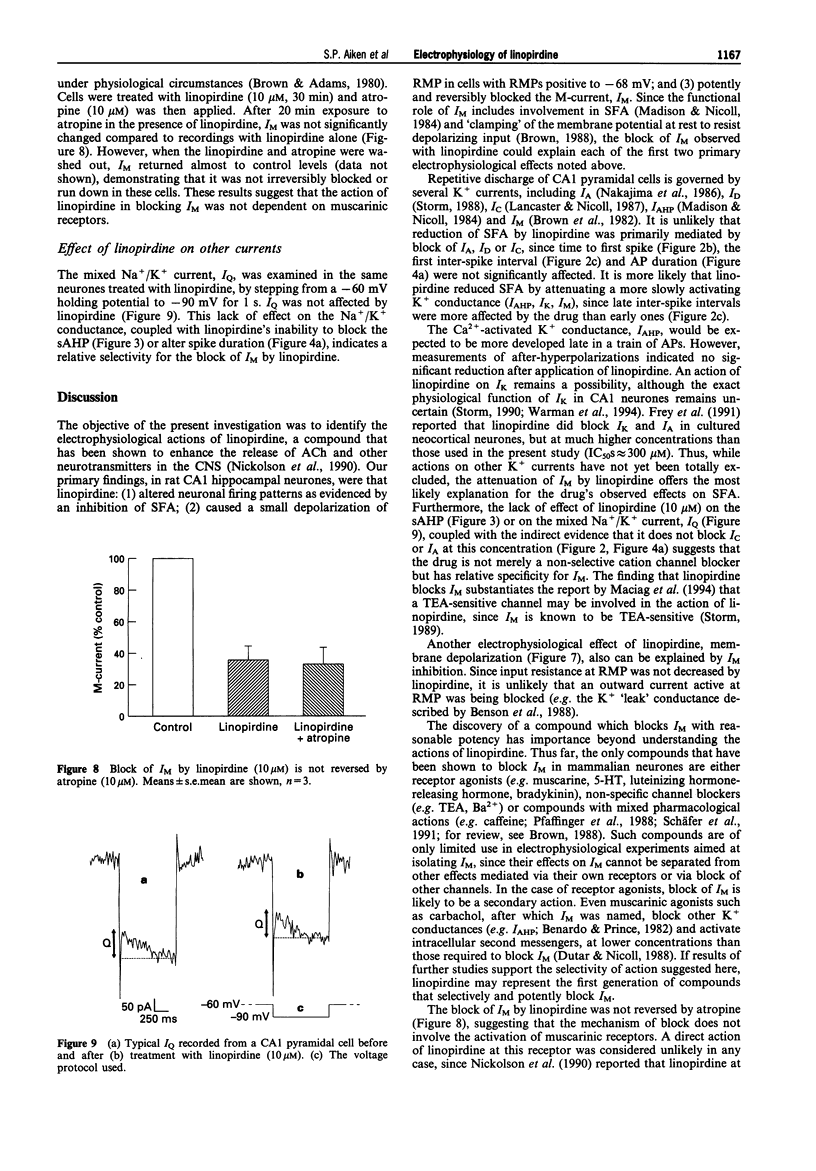Abstract
1. Linopirdine (DuP 996) has been shown to enhance depolarization-induced release of several neurotransmitters in the CNS through a mechanism which may involve K+ channel blockade. The electrophysiological effects of linopirdine were therefore investigated directly, by use of conventional voltage recording and single electrode voltage-clamp. 2. Linopirdine (10 microM) reduced spike frequency adaptation (SFA) in rat hippocampal CA1 pyramidal neurones in vitro. The reduction of SFA comprised an increase in number of spikes and a reduction in inter-spike intervals after the first, but with no effect on time to first spike. Linopirdine also caused a voltage-dependent depolarization of resting membrane potential (RMP). 3. M-current (IM), a current known to underlie SFA and to set RMP, was blocked by linopirdine in a reversible, concentration-dependent manner (IC50 = 8.5 microM). This block was not reversed by atropine (10 microM). 4. Linopirdine did not affect IQ, the slow after-hyperpolarization following a spike train, or spike duration. 5. Linopirdine may represent a novel class of K+ blocker with relative selectivity for the M-current. This block of IM is consistent with the suggestion from a previous study that linopirdine may affect a tetraethylammonium-sensitive channel, and it could be speculated that IM blockade may be involved with the enhancement of neurotransmitter release by linopirdine.
Full text
PDF





Selected References
These references are in PubMed. This may not be the complete list of references from this article.
- Benardo L. S., Prince D. A. Ionic mechanisms of cholinergic excitation in mammalian hippocampal pyramidal cells. Brain Res. 1982 Oct 14;249(2):333–344. doi: 10.1016/0006-8993(82)90067-1. [DOI] [PubMed] [Google Scholar]
- Benson D. M., Blitzer R. D., Landau E. M. An analysis of the depolarization produced in guinea-pig hippocampus by cholinergic receptor stimulation. J Physiol. 1988 Oct;404:479–496. doi: 10.1113/jphysiol.1988.sp017301. [DOI] [PMC free article] [PubMed] [Google Scholar]
- Brown D. A., Adams P. R., Constanti A. Voltage-sensitive K-currents in sympathetic neurons and their modulation by neurotransmitters. J Auton Nerv Syst. 1982 Jul;6(1):23–35. doi: 10.1016/0165-1838(82)90019-4. [DOI] [PubMed] [Google Scholar]
- Brown D. A., Adams P. R. Muscarinic suppression of a novel voltage-sensitive K+ current in a vertebrate neurone. Nature. 1980 Feb 14;283(5748):673–676. doi: 10.1038/283673a0. [DOI] [PubMed] [Google Scholar]
- Brown D. A., Marrion N. V., Smart T. G. On the transduction mechanism for muscarine-induced inhibition of M-current in cultured rat sympathetic neurones. J Physiol. 1989 Jun;413:469–488. doi: 10.1113/jphysiol.1989.sp017664. [DOI] [PMC free article] [PubMed] [Google Scholar]
- Brown D. M-currents: an update. Trends Neurosci. 1988 Jul;11(7):294–299. doi: 10.1016/0166-2236(88)90089-6. [DOI] [PubMed] [Google Scholar]
- Dutar P., Nicoll R. A. Classification of muscarinic responses in hippocampus in terms of receptor subtypes and second-messenger systems: electrophysiological studies in vitro. J Neurosci. 1988 Nov;8(11):4214–4224. doi: 10.1523/JNEUROSCI.08-11-04214.1988. [DOI] [PMC free article] [PubMed] [Google Scholar]
- Halliwell J. V., Adams P. R. Voltage-clamp analysis of muscarinic excitation in hippocampal neurons. Brain Res. 1982 Oct 28;250(1):71–92. doi: 10.1016/0006-8993(82)90954-4. [DOI] [PubMed] [Google Scholar]
- Lancaster B., Adams P. R. Calcium-dependent current generating the afterhyperpolarization of hippocampal neurons. J Neurophysiol. 1986 Jun;55(6):1268–1282. doi: 10.1152/jn.1986.55.6.1268. [DOI] [PubMed] [Google Scholar]
- Lancaster B., Nicoll R. A. Properties of two calcium-activated hyperpolarizations in rat hippocampal neurones. J Physiol. 1987 Aug;389:187–203. doi: 10.1113/jphysiol.1987.sp016653. [DOI] [PMC free article] [PubMed] [Google Scholar]
- Maciag C. M., Logue A. R., Tinker W. J., Saydoff J. A., Tam S. W., Zaczek R. Studies on the role of K+, Cl- and Na+ ion permeabilities in the acetylcholine release enhancing effects of linopirdine (DuP 996) in rat cortical slices. J Pharmacol Exp Ther. 1994 Nov;271(2):891–897. [PubMed] [Google Scholar]
- Madison D. V., Nicoll R. A. Control of the repetitive discharge of rat CA 1 pyramidal neurones in vitro. J Physiol. 1984 Sep;354:319–331. doi: 10.1113/jphysiol.1984.sp015378. [DOI] [PMC free article] [PubMed] [Google Scholar]
- Nakajima Y., Nakajima S., Leonard R. J., Yamaguchi K. Acetylcholine raises excitability by inhibiting the fast transient potassium current in cultured hippocampal neurons. Proc Natl Acad Sci U S A. 1986 May;83(9):3022–3026. doi: 10.1073/pnas.83.9.3022. [DOI] [PMC free article] [PubMed] [Google Scholar]
- Pfaffinger P. J., Leibowitz M. D., Subers E. M., Nathanson N. M., Almers W., Hille B. Agonists that suppress M-current elicit phosphoinositide turnover and Ca2+ transients, but these events do not explain M-current suppression. Neuron. 1988 Aug;1(6):477–484. doi: 10.1016/0896-6273(88)90178-x. [DOI] [PubMed] [Google Scholar]
- Schäfer S., Béhé P., Meves H. Inhibition of the M current in NG 108-15 neuroblastoma x glioma hybrid cells. Pflugers Arch. 1991 Jul;418(6):581–591. doi: 10.1007/BF00370575. [DOI] [PubMed] [Google Scholar]
- Stansfeld C. E., Marsh S. J., Gibb A. J., Brown D. A. Identification of M-channels in outside-out patches excised from sympathetic ganglion cells. Neuron. 1993 Apr;10(4):639–654. doi: 10.1016/0896-6273(93)90166-o. [DOI] [PubMed] [Google Scholar]
- Storm J. F. An after-hyperpolarization of medium duration in rat hippocampal pyramidal cells. J Physiol. 1989 Feb;409:171–190. doi: 10.1113/jphysiol.1989.sp017491. [DOI] [PMC free article] [PubMed] [Google Scholar]
- Storm J. F. Potassium currents in hippocampal pyramidal cells. Prog Brain Res. 1990;83:161–187. doi: 10.1016/s0079-6123(08)61248-0. [DOI] [PubMed] [Google Scholar]
- Storm J. F. Temporal integration by a slowly inactivating K+ current in hippocampal neurons. Nature. 1988 Nov 24;336(6197):379–381. doi: 10.1038/336379a0. [DOI] [PubMed] [Google Scholar]
- Vickroy T. W. Presynaptic cholinergic actions by the putative cognitive enhancing agent DuP 996. J Pharmacol Exp Ther. 1993 Feb;264(2):910–917. [PubMed] [Google Scholar]
- Warman E. N., Durand D. M., Yuen G. L. Reconstruction of hippocampal CA1 pyramidal cell electrophysiology by computer simulation. J Neurophysiol. 1994 Jun;71(6):2033–2045. doi: 10.1152/jn.1994.71.6.2033. [DOI] [PubMed] [Google Scholar]


